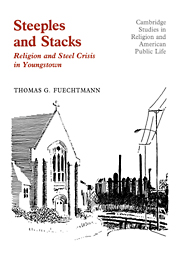Book contents
- Frontmatter
- Contents
- List of Tables and Figures
- Acknowledgments
- Introduction
- I Steeltown
- II The Industry
- III Shutdown
- IV Coping with Crisis: Community Response to the Shutdown
- V Religion and Urban Economic Crisis
- VI Launching a Movement
- VII The Plan
- VIII Negotiations
- IX Ending, Learning, Beginning Anew
- X Epilogue
- Notes
- References
- Index
V - Religion and Urban Economic Crisis
Published online by Cambridge University Press: 29 March 2010
- Frontmatter
- Contents
- List of Tables and Figures
- Acknowledgments
- Introduction
- I Steeltown
- II The Industry
- III Shutdown
- IV Coping with Crisis: Community Response to the Shutdown
- V Religion and Urban Economic Crisis
- VI Launching a Movement
- VII The Plan
- VIII Negotiations
- IX Ending, Learning, Beginning Anew
- X Epilogue
- Notes
- References
- Index
Summary
The phone call from Bishop Burt in Cleveland to Bishop Malone in Youngstown furnishes a convenient starting point for the Coalition story. And yet, dramatically satisfying as that event might be for beginning a narrative, it hardly explained the series of events that led to the Ecumenical Coalition.
On the one hand, the Coalition certainly was a new and different type of social organization. Nothing like it developed in the other steeltowns caught by the massive job terminations of 1977. As well, both the scale of the religious groups' involvement in such a project for local economic development and the nature of their leadership as a political agent for the local community were probably unprecedented.
On the other hand, it is possible to emphasize an opposite theme – to represent the Coalition as consistent with a tradition of concern in the churches for urban socioeconomic problems. Some members of the Coalition (Bishop Malone, for example) preferred to see the Coalition's thinking and action as rooted in and consistent with church tradition.
Actually, both themes are correct. The Coalition was new and different. At the same time, the Coalition effort did have strong roots within the intellectual and cultural context of the Catholic and mainline Protestant churches. An explanation of how and why the Coalition came into existence must take both factors into account. The Coalition was a product both of history and of structural factors at a particular time and place.
- Type
- Chapter
- Information
- Steeples and StacksReligion and Steel Crisis in Youngstown, Ohio, pp. 102 - 145Publisher: Cambridge University PressPrint publication year: 1989

